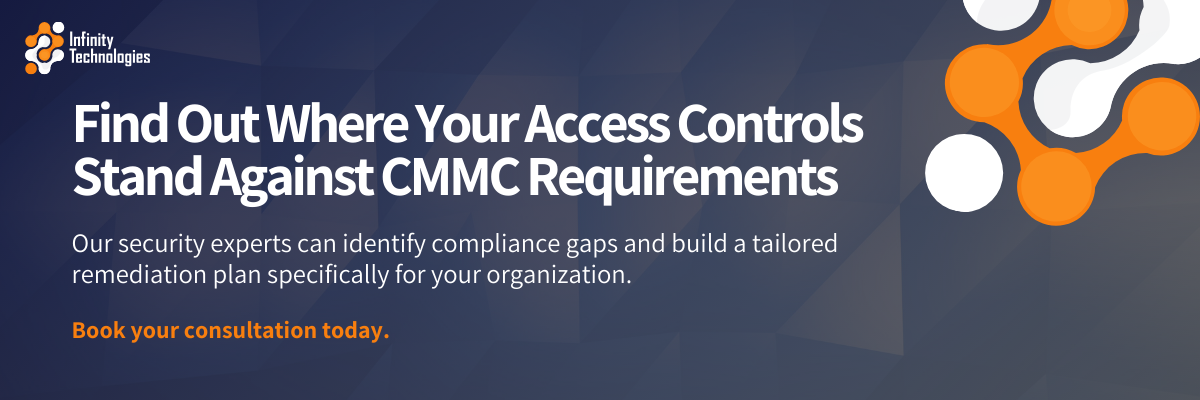While the laundry list of CMMC requirements can feel overwhelming, understanding and implementing robust access control measures is one of the highest-impact ways to strengthen your security posture while moving toward certification.
To simplify things and help get you started, we’ve rounded up our top access control tips for DoD contractors (plus a handy checklist to help you assess your current measures).
Here’s your practical guide to access control best practices for CMMC compliance:
Understanding Access Controls in the CMMC Framework
CMMC compliance draws heavily from NIST 800-171 controls, with access control requirements prominently featured in both frameworks. Specific requirements like AC.1.001 (limiting system access to authorized users) and AC.2.005 (employing the principle of least privilege) form the backbone of your defensive strategy.
But what exactly are access controls in practical terms? Think of them as the gatekeepers that determine:
- Who can access your systems and data
- What they can do once they have access
- When and where that access is permitted
Key Access Control Models for DoD Contractors
Access control best practices for CMMC compliance aren’t one-size-fits-all. Depending on your organization’s structure and risk profile (which we can help you figure out), different access control models might be appropriate:
- Discretionary Access Control (DAC): The owners of each resource decide who can access them
- Role-Based Access Control (RBAC): Access permissions are assigned based on job roles
- Mandatory Access Control (MAC): System-enforced controls based on security clearance levels
For most small to mid-sized government contractors, RBAC offers the optimal balance of security and administrative overhead. It also tends to align the most naturally with your organizational structure.
Practical Implementation Strategies: Access Control Tips for DoD Contractors
Moving from theory to practice, here’s how to implement effective access controls that meet CMMC requirements:
1. Establish Comprehensive IAM Policies
Document clear policies addressing:
- User provisioning and de-provisioning
- Password management requirements
- Privilege escalation procedures
- Regular access reviews and certification
Remember, assessors will want to see not just that you have these controls in place, but evidence they’re consistently followed.
2. Deploy Strong Authentication Mechanisms
Multi-factor authentication (MFA) is non-negotiable for CMMC compliance. It’s also one of the easiest access control tips for DoD contractors to implement—and no, it’s never too late to get started.
Enforce MFA for all users, especially those with administrative privileges or access to controlled unclassified information (CUI).
3. Apply Least Privilege Principles Rigorously
Provide users with only the minimum access needed to perform their job functions. This drastically reduces both the attack surface and the potential impact of credential compromise.
One of our clients, a logistics and consulting company pursuing CMMC Level 2, successfully implemented least privilege by:
- Identifying all 35 employees who needed access to CUI
- Creating granular role definitions aligned with job responsibilities
- Reducing standing admin privileges
- Establishing processes for regular security policy reviews and updates
Common Access Control Challenges for CMMC Compliance
Even with the best intentions, implementing access control best practices for CMMC compliance can be challenging. We consistently hear about issues in areas like:
Balancing Security with Productivity
Overly restrictive controls can hamper user productivity and lead to workarounds that create even bigger security gaps. Finding the right balance requires understanding both your security requirements and business workflows.
Managing Third-Party Access
Contractors often work with subcontractors and vendors who need access to systems containing CUI. Establishing proper controls for external parties is key, and it takes special attention to provisioning, monitoring, and de-provisioning processes.
Maintaining Documentation and Evidence
Assessors will expect comprehensive documentation of your access control policies and evidence of their implementation. This includes regular access reviews, privilege modifications, and incident response to unauthorized access attempts. Plenty of small government contractors struggle to stay on top of this (if they get started with it at all).
As specialists in CMMC compliance, our Charlottesville IT support experts can significantly accelerate your access control efforts while reducing the burden on your internal team. Learn more about our services.
Integrating Access Controls With Your Defense-in-Depth Strategy
Access control isn’t an isolated compliance requirement—it’s a cornerstone of the comprehensive defense-in-depth approach we champion for our clients.
[VIDEO]
Effective access control measures complement:
- Perimeter security: By ensuring that even if perimeter defenses fail, unauthorized users face additional barriers
- Data protection: By limiting who can view, modify, or extract sensitive information
- Incident response: By reducing the potential impact of security incidents
For a successful CMMC assessment, we strongly recommend enlisting an experienced MSP familiar with defense contractor environments. We aren’t just saying that because we’re biased and would love to work with you—C3PAOs themselves advise taking a step above any others.
Your CMMC Compliance Access Control Checklist
Use this straightforward checklist to evaluate your current access control measures:
- Multi-factor authentication implemented for all privileged and CUI-accessing accounts
- Documented access control policies and procedures
- Role-based access control model implemented
- Regular user access reviews conducted (at least quarterly)
- System for promptly disabling accounts when employees depart
- Privileged access management solution for administrative accounts
- Audit logs capturing all access changes and review processes
- Third-party access governed by formal agreements and limited to necessary resources
- Physical access controls aligned with digital access controls
- Training program educating users on access control policies
Don’t forget that while implementing these access control tips for DoD contractors is essential for CMMC compliance, truly effective security also relies on embedding these practices into your organizational DNA.
Need Help Implementing Access Controls? Partner With Infinity Technologies: Managed IT Support in Charlottesville, VA
If reviewing our checklist has revealed gaps in your access control measures—or if you simply don’t have the internal bandwidth to address these requirements promptly—you’re in the right place.
Many defense contractors find themselves in similar positions, especially as assessment deadlines approach. The good news? You don’t have to navigate this journey alone.
Contact our team today for a no-obligation consultation. We’ll help you turn those checklist gaps into an actionable roadmap for compliance success.



